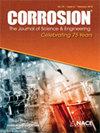Corrosion resistance of 309L stainless steel claddings on carbon steel produced with wire-fed directed energy deposition
IF 1.3
4区 材料科学
Q4 MATERIALS SCIENCE, MULTIDISCIPLINARY
引用次数: 0
Abstract
Additive manufacturing tools are capable of applying overlay austenitic stainless steel (SS) claddings to carbon steel components. The benefits of this approach over arc welding include a smaller heat-affected zone, residual stress reduction, and material savings. In particular, wire-directed energy deposition (DED) is a suitable technique because of its low material cost and high rate of production compared to other additive manufacturing methods. However, metallurgical variations in composition, phase fraction, and microsegregation can potentially influence the corrosion behavior of such claddings. In this work, 309L SS is clad on carbon steel substrates and electrochemical methods are used to measure their general and pitting corrosion resistance in simulated marine environments (3.5 wt.% NaCl solutions). Two-layer claddings are fabricated with four laser powers to understand the effects of bulk chemical composition, austenite / δ-ferrite phase fractions, and individual phase compositions on corrosion behavior. The two-layer claddings are compared to a single layer cladding, wrought 304 SS, and the carbon steel substrate for a comprehensive assessment of corrosion performance. The two-layer claddings are remarkably resistant to general corrosion in the 3.5 wt.% NaCl environment because of their high Cr content (21.6 – 23.3 wt.% Cr). The single layer cladding exhibits localized corrosion at unmixed Fe-rich peninsulas that originate at the dissimilar metal boundary and protrude into the first cladding layer. All two-layer claddings possess higher pitting corrosion resistance than wrought 304 SS, demonstrating their effectiveness as a corrosion-resistant barrier. The pitting corrosion resistance is superior for claddings made with lower laser powers, due to low dilution and greater δ-ferrite contents.309L不锈钢包层在钢丝喂料定向能沉积碳钢上的耐腐蚀性能
增材制造工具能够将堆焊奥氏体不锈钢(SS)覆层应用于碳钢部件。与电弧焊接相比,这种方法的优点包括较小的热影响区、减少残余应力和节省材料。特别地,导线定向能量沉积(DED)是一种合适的技术,因为与其他增材制造方法相比,它的材料成本低,生产率高。然而,成分、相分数和微偏析的冶金变化可能会影响此类覆层的腐蚀行为。在这项工作中,309L SS被包覆在碳钢基体上,并使用电化学方法测量其在模拟海洋环境(3.5wt.%NaCl溶液)中的一般耐腐蚀性和耐点蚀性。用四种激光功率制作了两层覆层,以了解本体化学成分、奥氏体/δ-铁素体相分数和单个相成分对腐蚀行为的影响。将双层包层与单层包层、锻造304 SS和碳钢基体进行比较,以全面评估腐蚀性能。两层覆层由于其高Cr含量(21.6–23.3 wt.%Cr),在3.5 wt.%NaCl环境中具有显著的耐一般腐蚀性。单层包层在未混合的富铁半岛上表现出局部腐蚀,这些富铁半岛起源于不同金属边界并突出到第一包层中。所有双层覆层都比锻造304不锈钢具有更高的耐点蚀性能,证明了它们作为耐腐蚀屏障的有效性。由于低稀释度和较大的δ-铁氧体含量,用较低激光功率制成的覆层的耐点蚀性能优越。
本文章由计算机程序翻译,如有差异,请以英文原文为准。
求助全文
约1分钟内获得全文
求助全文
来源期刊

Corrosion
MATERIALS SCIENCE, MULTIDISCIPLINARY-METALLURGY & METALLURGICAL ENGINEERING
CiteScore
2.80
自引率
12.50%
发文量
97
审稿时长
3 months
期刊介绍:
CORROSION is the premier research journal featuring peer-reviewed technical articles from the world’s top researchers and provides a permanent record of progress in the science and technology of corrosion prevention and control. The scope of the journal includes the latest developments in areas of corrosion metallurgy, mechanisms, predictors, cracking (sulfide stress, stress corrosion, hydrogen-induced), passivation, and CO2 corrosion.
70+ years and over 7,100 peer-reviewed articles with advances in corrosion science and engineering have been published in CORROSION. The journal publishes seven article types – original articles, invited critical reviews, technical notes, corrosion communications fast-tracked for rapid publication, special research topic issues, research letters of yearly annual conference student poster sessions, and scientific investigations of field corrosion processes. CORROSION, the Journal of Science and Engineering, serves as an important communication platform for academics, researchers, technical libraries, and universities.
Articles considered for CORROSION should have significant permanent value and should accomplish at least one of the following objectives:
• Contribute awareness of corrosion phenomena,
• Advance understanding of fundamental process, and/or
• Further the knowledge of techniques and practices used to reduce corrosion.
 求助内容:
求助内容: 应助结果提醒方式:
应助结果提醒方式:


